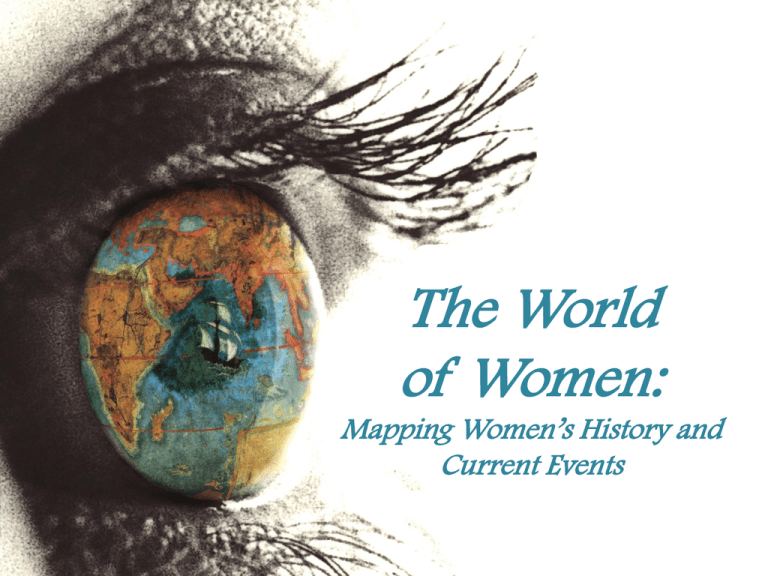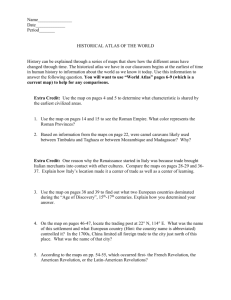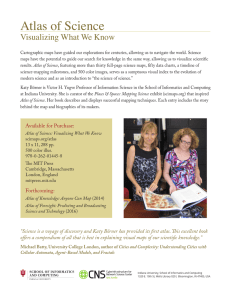The World of Women: Mapping Women’s History and Current Events
advertisement

The World of Women: Mapping Women’s History and Current Events On a map, the similarities and differences, the continuities and contrasts among women around the world become immediately apparent. The World of Women: Sex, Marriage, and Family According to The Penguin Atlas of Human Sexual Behavior , 80% of the marriages in China are arranged either by a matchmaker or the couple’s parents. In India, only 50% of 22- to 50-year-olds had met their partners privately before marriage. In Gambia in western Africa, one in three women were neither asked for their consent nor knew they were married until the ceremony had already taken place. The World of Women: Women at Work Women around the world face unequal opportunities to men in the workplace. According to The Penguin Atlas of Women in the World, “the nature of women’s participation in the…labor force is shaped by many factors, including marriage, reproductive rights, and the widely prevailing expectation that women have primary responsibility for family care.” Working women in the United States have made some advances over the last century. Most of the women working in the early part of the twentieth century were single, divorced, or widowed. During this period “nearly 40% of America’s five million working women held service jobs, either in private households or in facilities such as hotels, restaurants, laundries, and hospitals.” ( Routledge Historical Atlas of Women in America) The United States median earnings for men is $37,057. The United States median earnings for women is $27,194. (Census Atlas of the United States) One survey found that women slept an average two hours less than men and spent ten times longer on household work than men; men had over two hours a day for leisure, while women had only five minutes; and men spent less than one hour per week on cooking, while women spent fifteen hours per week. (The Penguin Atlas of Women in the World) The World of Women: Education The education of girls has an enormous impact on families around the world. “Women with no education are half as likely as women with a secondary education to immunize their children.” (The World Bank Atlas) According to The Penguin Atlas of Women in the World, nearly a billion people in the world are illiterate, about two-thirds of whom are women. Generally illiteracy is mostly a function of poverty and limited educational opportunity. Higher rates of illiteracy for women, however, also suggest entrenched gender discrimination. And illiteracy increases women’s dependency on men. By the turn of the century, the drive by leading physicians to strengthen their profession by upgrading medical education had forced the closure of many small schools, including a number founded specifically to train women. Most of the new university-based schools accepted only men. (Routledge Historical Atlas of Women in America) “By 1910, women represented nearly 40% of the nation’s college enrollment.” However, “attending college…did not provide the same career opportunities that it did for men.” (The Routledge Historical Atlas of Women in America) According to the Census Atlas of the United States, just over one-third of young adults were attending college in 2000. Among young-adult women, 37% attended college, compared with 31% of men. Even though there were slightly more men than women in this age group, the college student body was dominated by women (54% compared to 46%). There continue to be significant gender differences in subjects studied and degrees taken. Women remain dramatically under-represented among students and faculty in the sciences, and in technology and engineering. ( The Penguin Atlas of Women in the World) The World of Women: Power and Government Nowhere in the world are women represented in government in proportion to their population. Female representation in government is important to defend the rights of women and to enhance the nature of government with a true perspective of the governed. Many of the southern states that were conservative in allowing women the right to vote also did not ratify the Equal Rights Amendment for women in 1972, aimed at ending any remaining discrimination based on gender. The proposal has been reintroduced unsuccessfully in every Congress since 1982. ( Atlas of American Women) By 1980, women were voting more consistently than men. Women were now in a position to decide national elections if enough of them voted the same way. Female voters in 1996 turned out in such numbers for Democrat Bill Clinton that they carried the election, offsetting men’s Republican and third-party votes…and provided the margin of victory in 14 Senate races and three gubernatorial campaigns. ( The Routledge Historical Atlas of Women in America) Of the 26.4 million veterans in the United States in 2000, …1.6 million were women. In the most recent period of service, 15.7% were women. ( Census Atlas of the United States) The World of Women: Women Making History Women in the American Revolution: Blue=boycotting British goods Pink=use of physical force Yellow=food, supplies or nursing care Green=clandestine assistance (The Routledge Historical Atlas of Women in America) Nearly 400,000 women actively worked for the U.S. in World War II. More than 1,600 female nurses were decorated for meritorious service and bravery under fire. However, gender discrimination in the military was pervasive. Many women were ineligible for military benefits or even meals in the officers’ mess. ( The Routledge Historical Atlas of Women in America) The World of Women: Health and Welfare Cigarette smoking kills 178,000 women in the U.S. each year, and lung cancer is the fastest growing cancer-causing death in women. (The Tobacco Atlas) The World of Women: Literature The World of Women: Society and Culture A rise in religious fundamentalism in many countries is resulting in heightened legal and social restrictions on women. (The Penguin Atlas of Women in the World) The World of Women: Sports and Leisure Quest for beauty: A preoccupation with weight and body image has become an intrinsic part of the lives of women and girls. This is particularly so in the United States, but eating disorders are also noticeably increasing in Europe, Japan, and the countries of the former Soviet Union. And women around the world undergo a staggering amount of suffering in the pursuit of beauty. (The Penguin Atlas of Women in the World) Women were barred from the first modern Olympic Games in 1896. By 1900, women were invited to compete in tennis, croquet, golf, and yachting. Women were not allowed to run the marathon until 1984. Some countries have low percentages of participating women due to cultural or religious restrictions. However, women make up more than 50% of the television audience viewing the Olympics. (The State of Women in the World Atlas) Title IX legislation forced high schools and universities to provide a semblance of equal opportunity for women. States with no basketball at all soon had 300-500 high schools playing the game. Girls’ high school basketball more than quadrupled between 1971 and 1980. (Atlas of American Sport) Life expectancies are increasing worldwide just as birthrates are declining. Melissa Gentry, GIS Research and Map Collection mgentry@bsu.edu



